
The Exocoetidae are a family of marine fish in the order Beloniformes class Actinopterygii, known colloquially as flying fish or flying cod. About 64 species are grouped in seven to nine genera. While they cannot fly in the same way a bird does, flying fish can make powerful, self-propelled leaps out of the water where their long wing-like fins enable gliding for considerable distances above the water's surface. The main reason for this behavior is thought to be to escape from underwater predators, which include swordfish, mackerel, tuna, and marlin, among others, though their periods of flight expose them to attack by avian predators such as frigate birds.
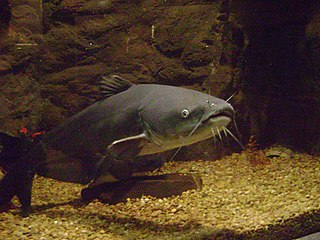
The blue catfish is the largest species of North American catfish, reaching a length of 165 cm (65 in) and a weight of 68 kg (150 lb). The typical length is about 25–46 in (64–117 cm). The fish can live to 20 years. The native distribution of blue catfish is primarily in the Mississippi River drainage, including the Missouri, Ohio, Tennessee, and Arkansas Rivers, The Des Moines River in South Central Iowa, and the Rio Grande, and south along the Gulf Coast to Belize and Guatemala. These large catfish have also been introduced in a number of reservoirs and rivers, notably the Santee Cooper lakes of Lake Marion and Lake Moultrie in South Carolina, the James River in Virginia, Powerton Lake in Pekin, Illinois, and Lake Springfield in Springfield, Illinois. This fish is also found in some lakes in Florida. The fish is considered an invasive pest in some areas, particularly the Chesapeake Bay. Blue catfish can tolerate brackish water, thus can colonize along inland waterways of coastal regions.

Caturus is an extinct genus of fishes in the family Caturidae. Fossils of this genus range from 200 to 109 mya.

The swallow-tailed gull is an equatorial seabird in the gull family, Laridae. It is the only species in the genus Creagrus, which derives from the Latin Creagra and the Greek kreourgos which means butcher, also from kreas, meat; according to Jobling it would mean "hook for meat" referring to the hooked bill of this species. It was first described by French naturalist and surgeon Adolphe-Simon Neboux in 1846. Its scientific name is originally derived from the Greek word for gull, "Glaros" and via Latin Larus, "gull" and furca "two-tined fork". It spends most of its life flying and hunting over the open ocean. The main breeding location is in the Galápagos Islands, particularly the rocky shores and cliffs of Hood, Tower and Wolf Islands, with lower numbers on most of the other islands. It is more common on the eastern islands where the water is warmer.

Cheilopogon is a genus of flyingfishes.

The fork-tailed storm petrel is a small seabird of the storm petrel family Hydrobatidae. It is the second-most abundant and widespread storm petrel and is the only bird in its family that is bluish-grey in colour.

Cheilopogon pinnatibarbatus japonicus is a subspecies of flyingfish of the family Exocoetidae, found in the seas around Japan. Its length is up to 50 cm.

Ictalurus is a genus of North American freshwater catfishes. It includes the well-known channel catfish and blue catfish.
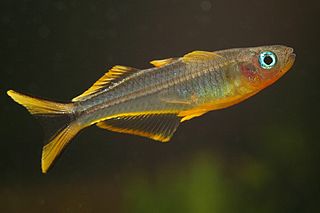
The forktail blue-eye is a species of fish in the subfamily Pseudomugilinae. It is endemic to Papua New Guinea south-east of Popondetta, where found in rainforest streams.
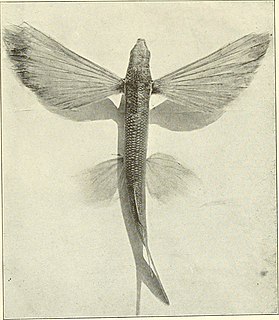
The California flying fish, Cheilopogon pinnatibarbatus californicus, is a subspecies of Bennett's flying fish. Prior to the 1970s, the California flying fish was known as a distinct species, with the scientific classification Cypselurus californicus. It may grow up to 19 inches (48 cm) in length and is the largest member of the flying fish family. It is found in the Eastern Pacific Ocean, from Oregon to Baja California. As with all other flying fish, the California can not actually fly, but it can launch itself into the air, using its specially adapted fins to glide along the surface.

The Atlantic flyingfish is a flying fish in the family Exocoetidae. It was first described by the French zoologist, Achille Valenciennes in a 22-volume work entitled Histoire naturelle des poissons, which was a collaboration with fellow zoologist Georges Cuvier.

Cyclocheilichthys is a genus of ray-finned fish in the family Cyprinidae containing approximately eight valid species. They are native to freshwater habitats in Southeast Asia and China. Two additional species are alternately placed in the genus Anematichthys.
Cyclocheilichthys furcatus, the Mekong giant barb, is a species of cyprinid fish in the genus Cyclocheilichthys found in the Mekong.

Cirrhimuraena is a genus of eels in the snake eel family Ophichthidae.
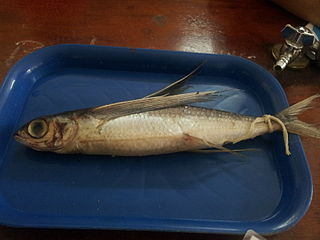
Cheilopogon nigricans, the blacksail flyingfish, also known as African flyingfish, or leaping flyingfish, is a flying fish in the family Exocoetidae. It is an oceanodromous, plankton-eating marine fish which has commercial value.
The Flying Fish Festival is one of the traditional ceremonies of the Taiwanese indigenous Yami people, which live on a tiny island off the southeastern coast of Taiwan called Orchid Island. The Flying Fish Festival comes from the legends of the Yami people and constitutes the social norms of their society. During the festival period, the Yami people need to be very careful of their actions and words in order not to violate the norms. In addition to the Yami's cultural heritage, the Flying Fish Festival also implies the respect for the natural environment and sustainable ecological perceptions.
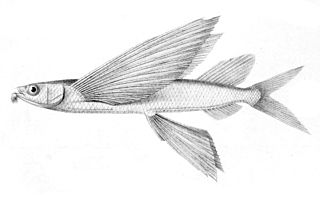
Cheilopogon pinnatibarbatus, Bennett's flying fish, is a species of flying fish which has a circumglobal distribution in tropical and subtropical seas. It is an epiplegaic species which feeds on zooplankton and small fishes and is capable of leaping out of the water and gliding over the surface.
Cheilopogon dorsomacula is a species of fish in the family Exocoetidae.
Hemibagrus furcatus is a species of bagrid catfish found in Sabah, Malaysia. This species reaches a length of 15 cm (5.9 in).













